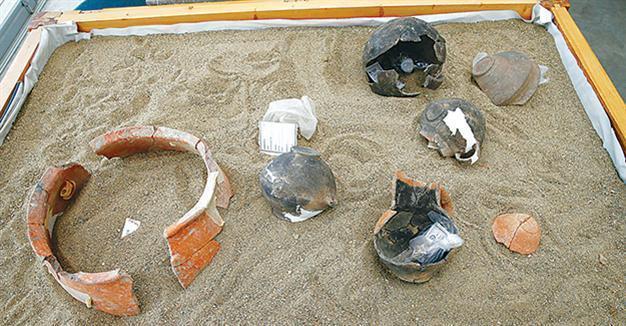Ancient bone to shed light on Anatolian history
İZMİR – Anadolu Agency
 Researchers at Boston University have detected DNA samples in a 5,000-year-old temporal bone discovered during excavations at İzmir’s Yeşilova mound, one of the oldest excavation areas in the history of Anatolia.
Researchers at Boston University have detected DNA samples in a 5,000-year-old temporal bone discovered during excavations at İzmir’s Yeşilova mound, one of the oldest excavation areas in the history of Anatolia. The DNA sample is expected to provide important clues related to Anatolian history.
Excavations head Professor Zafer Derin said the Yeşilova mound excavations, which are backed by the Culture and Tourism Ministry, Ege University, the İzmir Metropolitan Municipality and Bornova Municipality, provided new information to the fields of archaeology, science and education.
Derin said the excavations first revealed that the history of İzmir dated back to 8,500 years ago, allowing researchers to access important data on the life of the early inhabitants around İzmir and the Aegean by examining their tools.
Last year the team found a temporal bone piece from a 5,000 year-old skeleton in the region, which they sent to Boston University in the U.S., where examinations have been carried out on the bone’s DNA sample.
“DNA analysis was made on this 5,000-year-old temporal bone that we found last year. They used a method that is used only in four places in the world. The basic goal was to detect the DNA, which they managed to do. This will help us find things like the eye color, height, disease and hair color of a human who lived 5,000 years ago. We will learn if this human was European or Anatolian,” Derin stated.
Learning about ancestors
Derin said the goal of the Yeşilova mound excavations was not only to unearth significant findings about the area, but to contribute to scientific knowledge more generally.
“Before anything else, we will try to learn about our own origin and where we came from. We roughly know that Turks came from Central Asia, but Anatolian people existed 8,500, 10,000 or 11,500 years ago. These people formed the origin of everything. So in a sense, we will find our ancestors through such work,” he said.
Although the excavation team found the bone belonging to a person who lived 5,000 years ago, they were unable to find this person’s skeleton.
“No full skeleton from this date has ever been found in excavations in the Aegean region. Maybe they buried their dead in the ground just like in Çatalhöyük, or maybe they left them for birds and wild animals. We don’t know,” Derin added.
He also said they had opened the excavation season earlier than usual this year, and that works in Yeşilova focused on settlements from both 8,500 years and 5,000 years ago.
“We are searching for evidence from times of both war and peace. We try to understand the life of ancient peoples with the findings,” Derin said.
















